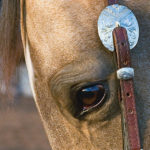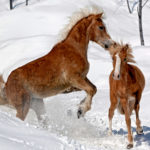Your horse’s tail length and thickness depend on four main factors: nutrition, environment, the care you provide, and genes. You can’t change his DNA, but by attending to the other three factors, you’ll encourage the best tail he’s capable of growing. Here’s what to do.

1. Feed well. High-quality forage (pasture or hay) is the basic, augmented with whatever concentrate your horse needs for his particular energy requirements. To make sure your horse’s feed is used to its fullest, be sure to maintain a good parasite-control program.
2. Consider supplements. Work with your vet and/or an equine nutritionist to decide if a supplement may be helpful for tail growth. Hair, like hooves, needs certain nutrients in the correct balance to flourish. These include the B vitamin biotin; the essential amino acids lysine and methionine; and the trace minerals zinc, copper, and iodine. Hoof supplements that supply these nutrients will also benefit hair growth.
3. De-snag his living quarters. Check stall walls, gates, and fences (plus trees or brush in the pasture) for obvious places where tail hair might become caught and pulled out. And, to avoid the ultimate disaster…be sure your horse is never turned out with a tail-chewer, equine or otherwise!
4. Ditch the itch. Rubbing demolishes tails. Protect your horse from anything that might cause a tail to itch, including harsh cleaning products. Also keep your horse’s underbelly, sheath or udder, and fold between the hind legs clean, as itching in these spots (where your horse can’t scratch) can cause tail-rubbing, too. Indentify and deal with any allergy problems your horse may have, and protect him from the tiny biting midges (culicoides) that can lead to serious rubbing.
5. Wash wisely. For best results, use a hair shampoo (for horses or humans—no dishwashing or laundry detergent), and be sure to fully rinse all the suds. (A vinegar rinse helps.) Apply a good conditioner, rinsing the tail head completely but leaving some product on the tail hairs. Finish with a detangling product to increase the tail’s silkiness—it looks great plus helps fend off knotting. Avoid over-washing; shampoo often enough to keep the tail from becoming filthy (at which point it tangles and breaks easily), but not so often as to dry it out. (Keeping it braided or bagged—see #8—helps reduce the need for washing and other handling. For specifics in dealing with urine-stained tails, search tail care for mares at HorseandRider.com.)
6. Brush sparingly. Some savvy grooms never even use a brush at all, preferring to de-knot and smooth the tail using their fingers and liberal applications of detangler. Others prefer careful use of a wide-tooth comb; still others say the right kind of brush, properly wielded, works well. Technique is paramount: Always start at the bottom and work up for gentlest effects during detangling and smoothing. If you use a comb or brush, use your other hand to hold the tail hair tightly above where you’re working to prevent hair pulls that go through to the tail head and result in hair loss.
7. Bang it. Blunt-cut the tail straight across at or just above the fetlocks to keep it from being stepped on when you back your horse up.
8. Braid and/or bag it. These options offer additional protection. One long braid or, for thicker tails, two or three braids hanging down work well for some horses in some environments. Always start a braid below the tailbone, keeping the braids relaxed to avoid discomfort and rubbing. Secure the braids with hair-friendly elastic bands. Placing the braids within a commercial tail bag protects from snags and can extend the effects of conditioners. (Caution: Never fasten anything around the tail bone itself, as it can cut off circulation and lead to tissue death.)
9. Fend off flies. Practice scrupulous fly-control measures to moderate tail swishing, which can lead to breakage and hair loss. This is equally important whether you leave the tail down or braid/bag it.





